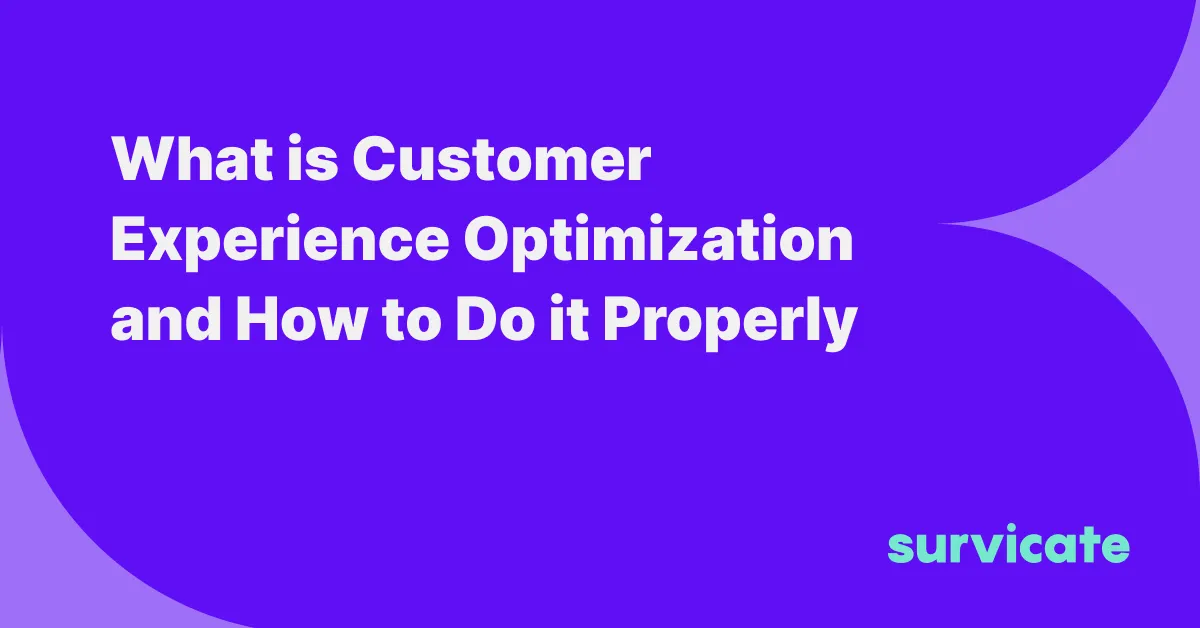Tl;dr;
- Automated customer feedback: Implement satisfaction surveys, NPS, and CSAT through automation to promptly gather and respond to customer insights, enhancing service quality.
- AI-powered personalization: Utilize AI to tailor customer experience design, predicting behaviors and preferences for more individualized interactions.
- Efficient multichannel integration: Ensure a seamless omnichannel customer experience with consistent communication and service quality.
- Data-driven decision-making: Leverage analytics and reporting to understand customer behaviors and improve digital CX strategies.
- Scalability and cost-effectiveness: Adopt CXA to scale your services efficiently, reducing operational costs and boosting customer retention.

Imagine a world where intelligent systems seamlessly manage customer interactions. This isn't science fiction; it's customer experience automation (CXA) and revolutionizing how businesses engage with consumers.
For business leaders and customer service innovators aiming to elevate their game, the problem is clear: how to enhance customer satisfaction and loyalty without overwhelming your team.
CXA works around the clock to minimize costs and maximize relationships by automating feedback, segmenting audiences, and delivering personalized communications. Stick around to discover 10 smart ways automation can revamp your customer experience, making your brand not just profitable but unforgettable.
Overview of Customer Experience Automation
Customer Experience Automation (CXA) is a strategic approach focused on streamlining and enhancing interactions between your business and your customers. By leveraging advanced technologies, CXA aims to automate the entire customer journey from initial contact to post-sale support.
Key Components of CXA:
- Automated interactions: Utilize AI chatbots and automatic email campaigns to maintain communication and engage with customers at multiple touchpoints.
- Robotic Process Automation (RPA): Deploy bots to handle routine tasks, reducing manual errors and increasing efficiency.
- Integration with CRM systems: Ensure a seamless flow of customer information across platforms for a unified, personalized experience.
CXA involves automating simple tasks and extends to complex processes that accompany a customer throughout their lifecycle with a brand. By integrating CXA, your company can offer consistently high-quality, efficient, personalized interactions.
Why CXA Matters:
- Increased efficiency: Free up your employees' time to focus on higher-value work.
- Consistency and reliability: Offer a predictable and reliable customer experience.
- Personalized interactions: Tailor experiences to individual customer needs and preferences.
By adopting Customer Experience Automation, you can drive customer satisfaction, loyalty, and business growth without the added burden of manual process management.
Key Elements of Customer Experience Automation
Customer Experience Automation (CXA) consists of critical components that work together to optimize your interactions with customers, ultimately enhancing satisfaction and engagement.
Artificial Intelligence
AI forms the backbone of CXA, enabling personalized customer interactions by predicting customer behavior and preferences. With AI, you can deliver a tailored experience to each customer, increasing efficiency and satisfaction.
Analytics and Reporting
Your ability to improve customer experiences hinges on understanding them. Analytics and reporting tools measure the effectiveness of your touchpoints, providing insights into customer behavior and operational performance, thus guiding your decision-making process.
Multichannel Integration
CXA necessitates a cohesive presence across all channels. Your customers expect a seamless experience, whether they interact with you via social media, email, or live chat. Multichannel integration ensures consistency and availability regardless of how or where a customer reaches out.
Customer Journey Mapping
Mapping out each step of the customer journey gives you a clear view of the customer experience from beginning to end. It enables the identification of key areas where automation can have the greatest impact, streamlining the path to purchase and improving customer interactions.
Automated Customer Interactions
Automated customer interactions are direct communications with customers that are triggered by specific behaviors or milestones. From welcome screens for new users to automated support messages, these interactions save time and provide immediate, consistent service to your customers.
Benefits of Customer Experience Automation
Customer experience automation (CXA) transforms how you interact with your customers across various touchpoints. With a strategic implementation, CXA can significantly enhance service delivery, satisfaction, and operational efficiency.
Improved Customer Satisfaction
By utilizing tools that provide 24/7 customer support, such as AI chatbots, your customers can receive instant assistance at any time of day, leading to a noticeably better customer experience.
Streamlines Customer Journeys
Automation identifies and simplifies your customers' steps, from first contact to post-purchase, ensuring a smooth and efficient journey.
Deliver Consistent Experiences
Ensure that every interaction is consistent and of high quality, minimizing the chances of human error and varying service levels.
Increased Efficiency
Tasks that previously took significant time and resources can now be automated, freeing up your staff to focus on higher-value activities.
Strengthen Customer Relationships
Automation facilitates more frequent and reliable interactions, fostering trust and loyalty between you and your customers.
Enhanced Personalization
Leverage customer data to automate personalized communications, which can result in higher engagement and conversions.
Data-Driven Insights
Automated processes can capture critical customer data, providing valuable insights for informed decision-making and continuous improvement.
Scalability
CXA solutions grow with your business, easily scaling to accommodate additional customers or services without a proportional increase in support costs.
Become More Profitable
By reducing operational costs and increasing customer retention, CXA can directly impact your bottom line.
10 Ways to Use Automation That Improve The Customer Experience
Enhancing your customer's experience is paramount in today's competitive business landscape. By leveraging the power of automation, you can provide more efficient, consistent, and personalized service that meets your customers' needs and expectations.
Automate Customer Feedback (Satisfaction Surveys, NPS, CSAT)
Automating customer feedback collection through satisfaction surveys, Net Promoter Score (NPS), or Customer Satisfaction Score (CSAT) enables you to gather insights promptly and consistently. It ensures that you're always in tune with customer perceptions and can react quickly to feedback.
Integrating customer experience data with CRM data
Merge your customer experience feedback directly with your CRM data. This integration offers a complete view of customer interactions, improving service personalization and enabling more informed business decisions.
Closing the feedback loop with the help of automation
Automation can help close the feedback loop by triggering follow-up actions based on customer responses. Whether directing concerns to support teams or acknowledging positive feedback, it ensures customers feel heard.
Automate Customer Segmentation and Priority
Automation can segment customers based on behavior, preferences, or value. Prioritize support and resources effectively to enhance engagement and satisfaction for different customer groups.
Automate Customer E-mails (From Personalized Onboarding to Check-Ins)
Send personalized onboarding emails, regular updates, and check-ins using automation. Tailor these communications to individual user actions to maintain a connection and encourage continued engagement.
Aligning real-time CX data with business intelligence data
Use automation to feed real-time customer experience data into lead intelligence software. Analyze this data to recognize patterns, predict customer needs, and inform strategic decisions.
Custom customer journeys / Personalized communications
Craft personalized customer journeys using automated communications. Deliver custom messages and solutions based on each customer's unique interactions and behaviors.
Automate The Customer Service Process (From ChatBots to Auto-Generated Customer Help-Desk Tickets)
Deploy chatbots for instant, 24/7 responses and use automation to generate help desk tickets. Streamline your customer service process to quickly address queries and issues.
Automate your Low-Touch Onboarding Processes
Simplify the onboarding process with automated guides, information packets, and helpful resources tailored to new users' actions and feedback, ensuring a smooth start to their customer journey.
Automate Notifications For Customers at risk of Churning
Identify customers at risk of churning using automation tools. Engage them with targeted notifications and offers to address their concerns and improve retention.
Future Trends in Customer Experience Automation
In the realm of customer experience automation, you can expect significant strides in technology that cater to evolving consumer expectations, with advancements focusing on personalization, efficiency, and seamless interactions.
Advancements in AI and ML will evolve to offer more nuanced and context-aware automation in customer service.
Predictive Customer Analytics will become more sophisticated, enabling your business to anticipate customer needs and provide solutions proactively. This could range from suggesting products based on past purchases to flagging potential service issues before they arise.
Hyper-personalization will go beyond addressing customers by name. Systems will tailor experiences in real-time by analyzing data points like browsing behavior and purchase history.
Voice and conversational interfaces will be more intuitive, capable of handling complex tasks, and offer a more natural conversational experience. Customers will increasingly use voice and chatbots for a wider range of services as they become more advanced.
Omnichannel Customer Engagement - your business will be expected to provide a seamless customer experience across all touchpoints. AI-driven automation will ensure that every channel, from social media to in-store interactions, is integrated, providing consistency and ease for the customer.
Build your CX automation with Survicate
Automation has emerged as a key player in the quest to refine the entire customer. It's not about replacing the human touch; rather, it's about enhancing it. Customer experience automation (CXA) leverages tools like satisfaction surveys and AI-powered personalization to ensure that every interaction feels tailor-made for the individual.
Enter Survicate—a powerful survey software that stands out in the realm of CX automation. With Survicate, businesses can effortlessly implement automated feedback collection, using NPS and CSAT surveys to capture real-time insights. This consolidates the process of understanding customer sentiments and empowers companies to act swiftly on this feedback, continuously improving their service quality.
Survicate offers a comprehensive solution for businesses looking to automate and personalize the customer experience at every stage of the lifecycle. By leveraging the power of Survicate, companies can ensure a seamless, integrated, and data-driven approach to customer interactions.
Experience the difference for yourself—sign up for a free 10-day trial of Survicate, granting full access to all the features of the Business Plan. Elevate your customer experience today.








.webp)


.webp)


.svg)

.svg)



